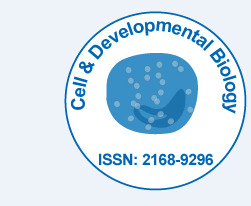
Cell & Developmental Biology
Open Access
ISSN: 2168-9296

ISSN: 2168-9296
Opinion Article - (2025)Volume 14, Issue 1
Embryonic Stem Cells (ESCs) represent a unique cellular state characterized by their capacity for unlimited self-renewal and pluripotency, the ability to differentiate into all three germ layers. The maintenance of this pluripotent state requires precise epigenetic regulation involving complex chromatin modifications, DNA methylation patterns, and non-coding RNA networks. Recent advances in single-cell epigenomics have revealed the intricate molecular mechanisms governing pluripotency maintenance and the transition to differentiated cell states.
The core pluripotency transcription factor network, consisting of Oct4, Sox2, and Nanog, establishes a transcriptional program that maintains ESC identity. These factors create extensive regulatory circuits through their binding to enhancer and promoter regions of target genes. Chromatin Immunoprecipitation sequencing (ChIP-seq) studies have demonstrated that these transcription factors co-occupy numerous genomic loci, forming what are termed "super-enhancers" that drive high-level expression of pluripotency-associated genes. The spatial organization of these regulatory elements within the nucleus further contributes to transcriptional control through the formation of Topologically Associating Domains (TADs) and chromatin loops.
Histone modifications play crucial roles in establishing and maintaining the pluripotent chromatin landscape. The presence of both activating (H3K4me3) and repressive (H3K27me3) histone marks at developmental gene promoters creates bivalent chromatin domains. These bivalent domains poise lineage-specific genes for rapid activation upon differentiation signals while maintaining their silenced state in pluripotent cells. The polycomb repressive complexes PRC1 and PRC2 are essential for establishing these repressive marks, while trithorax group proteins counteract polycomb function to maintain active chromatin states.
DNA methylation patterns undergo dynamic changes during early embryonic development and ESC differentiation. The DNA methyltransferases DNMT1, DNMT3A, and DNMT3B establish and maintain methylation patterns, while the TET family of enzymes catalyze DNA demethylation through iterative oxidation of 5-methylcytosine. The interplay between these opposing activities creates a dynamic methylation landscape that regulates gene expression and chromatin accessibility. CpG islands associated with pluripotency genes typically remain hypomethylated, while repetitive elements and imprinted loci show tissue-specific methylation patterns.
Non-coding RNAs, including microRNAs (miRNAs) and long non-coding RNAs (lncRNAs), provide additional layers of epigenetic regulation. The miR-290 cluster in mouse ESCs and the miR-371 cluster in human ESCs promote pluripotency maintenance by targeting differentiation-promoting transcripts. These RNA-mediated mechanisms create feedback loops that reinforce the pluripotent state while preparing cells for lineage commitment.
Metabolic reprogramming accompanies pluripotency establishment and maintenance. ESCs exhibit unique metabolic characteristics, including enhanced glycolysis, altered mitochondrial function, and distinct amino acid metabolism. The metabolic state directly influences epigenetic modifications through the availability of cofactors and substrates for chromatin-modifying enzymes. α-ketoglutarate serves as a cofactor for TET enzymes and JmjC domain-containing histone demethylases, linking cellular metabolism to epigenetic regulation. Similarly, S-adenosyl methionine availability affects DNA and histone methylation patterns, creating a direct connection between one-carbon metabolism and epigenetic state.
The maintenance of pluripotency in embryonic stem cells emerges from the integration of multiple epigenetic regulatory mechanisms operating across different molecular scales. The orchestrated action of transcription factors, chromatin modifications, DNA methylation, and non-coding RNAs creates a stable yet plastic cellular state capable of responding to developmental cues. Understanding these epigenetic networks has profound implications for regenerative medicine, disease modeling, and our fundamental understanding of cellular identity. Future research directions should focus on elucidating the temporal dynamics of epigenetic changes during differentiation and developing methods to precisely manipulate these regulatory networks for therapeutic applications.
Citation: Galey C (2025). Epigenetic Regulation of Pluripotency in Embryonic Stem Cells. Cell Dev Biol. 14:382.
Received: 28-Feb-2025, Manuscript No. CDB-25-38146; Editor assigned: 03-Mar-2025, Pre QC No. CDB-25-38146 (PQ); Reviewed: 17-Mar-2025, QC No. CDB-25-38146; Revised: 24-Mar-2025, Manuscript No. CDB-25-38146 (R); Published: 31-Mar-2025 , DOI: 10.35248/2168-9296.25.14.382
Copyright: © 2025 Galey C. This is an open-access article distributed under the terms of the Creative Commons Attribution License, which permits unrestricted use, distribution, and reproduction in any medium, provided the original author and source are credited.